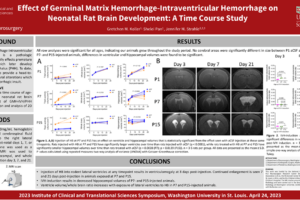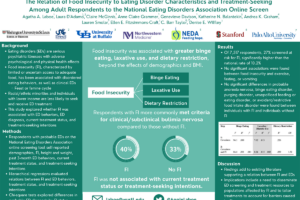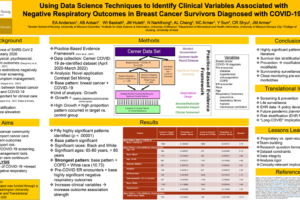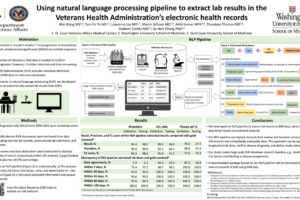2023 ICTS Symposium Posters
1. Massively Parallel Imaging Assay Elucidates Subtle Pathogenic Phenotypes of Mitochondrial Gene Variants
Introduction: Mutations in mitochondrial genes underlie numerous neurodegenerative diseases, yet the significance of most variants is uncertain concerning disease phenotypes. Many pathogenic mutations cause visibly distinct morphological differences in afflicted cells, allowing human cells to serve as proxies for patients when studying the genetic basis of disease. This postulate provides the basis for a pooled […]
2. Translational Evidence Associating NADPH Oxidase and Heparan Sulfate Proteoglycan Activity with Cerebral Amyloid Angiopathy in Alzheimer Patient Biopsies
Introduction: Most dementia patients have co-existing vascular contributions to cognitive impairment and dementia (VCID). Cerebral amyloid angiopathy (CAA), a form of vascular dementia, bridges the interplay between VCID and Alzheimer’s Disease (AD) pathology and cooccurs in 90% of patients with AD. The hallmark pathology of CAA is characterized by amyloid-ß deposition in cerebrovasculature. Reactive oxidative […]
3. Effect of Germinal Matrix Hemorrhage-Intraventricular Hemorrhage on Neonatal Rat Brain Development: A Time Course Study
Introduction: Germinal matrix hemorrhage-intraventricular hemorrhage (GMH-IVH) is a pathologic condition which preferentially effects premature neonates, some of which later develop posthemorrhagic hydrocephalus (PHH). To date, no study has attempted to provide a head-to-head comparison of structural alterations which occur based on age of hemorrhagic insult. This study aims to provide a time course of age-dependent […]
4. Development of Sutureless Vaso-Lock for Vascular Anastomosis
Introduction: Micro- and macrovascular anastomoses involve suturing together of blood vessels, which is a critical foundational surgical skill. However, it faces many challenges, such as decade-long training and inherent dexterity of the surgeon. Procedures are long and expensive, require specialized operating rooms and equipment, making them prohibitive in many hospitals. Our team has created a […]
5. Antigen-guided Depletion of Anti-HLA Antibody-producing Cells by HLA-Fc Fusion Proteins
Introduction: Platelet transfusion and transplantation of allogeneic stem cells and solid organs are life-saving therapies. Unwanted alloantibodies to non-self human leukocyte antigens (HLA) on donor cells increase the immunological barrier to these therapies and are important causes of platelet transfusion refractoriness and graft rejection. Although the specificities of anti-HLA antibodies can be determined at the […]
6. ASOs Targeting the miR-29b Binding Site in the GRN mRNA Increase Translation of Progranulin: Potential Therapeutic Strategy for Progranulin-deficient Frontotemporal Dementia
Introduction: Frontotemporal dementia (FTD) is a devastating neurological disease with no approved treatment or cure. One common cause of FTD is heterozygous loss-of-function GRN mutations, which result in haploinsufficiency of progranulin. Antisense oligonucleotides (ASOs) are emerging as a promising therapeutic modality for neurological diseases, but ASO-based strategies for increasing target protein levels are limited. Several […]
7. Lobe Specificity of Iron Binding to Transferrin Differentially Influences the Relationship Between Bone Morphogenetic Protein 6 and Hepcidin Expression in Mice
Introduction: The mechanisms by which changes in transferrin (TF) saturation regulate hepcidin are unclear. We reported that transgenic mice expressing mutant TF that block iron binding to either N-lobe (N-bl) or C-lobe (C-bl) have differences in erythropoietin sensitivity and hepcidin regulation. To characterize the differential regulation of the gene encoding hepcidin, Hamp1, in these mice […]
8. Evolution of a Functionally Intact but Antigenically Distinct Dengue Virus Fusion Loop
Introduction: A hallmark of Dengue virus (DENV) pathogenesis is the potential for antibody dependent enhancement (ADE), which is associated with deadly DENV secondary infection, complicates the identification of correlates of protection, and negatively impacts the safety and efficacy of DENV vaccines. ADE is linked to antibodies targeting the pre-Membrane (prM) protein and the fusion loop […]
9. A Tampon-like Xerogel Device for Non-hormonal Contraception
Introduction: An unplanned pregnancy can be an emotionally devastating experience for a woman. To expand non-hormonal choices for female-controlled contraceptive methods, this research aims to develop a drug-free, tampon-like xerogel device capable of fortifying natural contraceptive mechanisms within the female reproductive tract. Methods: Xerogel devices were fabricated by lyophilization of a hydrogel comprised of Carbopol® […]
10. A Pharmacogenetic Algorithm for Days 6-21 of Warfarin Therapy Predicts the Therapeutic Warfarin Dose
Introduction: Warfarin remains a commonly prescribed anticoagulant, use of which is complicated by significant inter-patient variability in the therapeutic dose and a narrow therapeutic index. Algorithms to refine the warfarin dose are needed, especially during days 6-21 of warfarin therapy, when iatrogenic hemorrhages are common. Objective: To develop clinical and genotype-guided dosing algorithms for days […]
11. A Masked, Controlled Trial of Median Nerve Stimulation for Tourette Syndrome
Introduction: A prior study showed that rhythmic, but not arrhythmic, 12 Hz stimulation of the median nerve (MNS) entrained the sensorimotor cortex EEG signal and found that 10 Hz MNS improved tics in Tourette syndrome (TS). However, no control condition was tested, and stimulation blocks lasted only 1 minute. We set out to replicate the […]
12. Pseudomonas Aeruginosa is Present in Sink Drains of Multiple ICU Wards at a Tertiary Medical Center
Introduction: Healthcare-associated infections are a rising threat to hospitalized patients. Pseudomonas aeruginosa reservoirs in the hospital environment have been connected to patient infections in intensive care units (ICUs), including the stem cell transplant and oncology (SCTO) ICU in Barnes Jewish Hospital. Sink drains were identified as a consistent source of antimicrobial resistant organism (ARO) growth, […]
13. Attenuated Cognitive Decline in Community-dwelling Older Adults with High Plasma Adropin Concentrations
Introduction: Adropin is highly expressed in post-mortem human brain samples relative to other tissues and correlates with RNA and protein signatures linked to cognitive decline. Increasing adropin levels in old C57BL/6J mice improves learning and memory. Whether circulating adropin levels correlate with cognitive decline in humans of advanced age is not known. Methods: We investigated […]
14. Decreasing Unnecessary Urinary Catheter Usage in the ICU
Introduction: Millions of indwelling catheters are placed each year to monitor urine output. Catheter associated urinary tract infections (CAUTIs) are the most commonly hospital-acquired infections and associated with urinary catheters. Previous efforts to decrease CAUTIs in the intensive care unit (ICUs), which are more likely to use urinary catheters, have had minimal success. Despite unclear […]
15. PET Imaging Cardiac Inflammation in CD36-deficient Individuals
Introduction: Fatty acid translocase CD36 regulates cardiac function, and its deletion in rodents associates with atrioventricular block and bradycardia and increasing risk of sudden death following prolonged fasting. Preclinical and clinical research show that monocyte chemotactic protein-1/chemokine (C-C motif) receptor 2 (MCP-1/CCR2) regulates myocardial remodeling and inflammation during cardiac disease. Our preliminary data, conducted with […]
16. Assessing the Impact of Comorbid Depressive and Anxiety Symptoms on Severity of Functional Impairment in a Nationally Representative Sample
Introduction: Performing self-care and domestic life tasks are key measures of functional independence for older adults. While both depression and anxiety symptoms have been correlated with increased functional limitation, these two disorders are most often studied separately, despite frequent co-occurrence and plausible interactive effects. This study examined the impact of comorbid depressive and anxiety symptoms […]
17. Identifying Factors Associated with Preeclampsia Using Electronic Health Records Data
Introduction: Chronic hypertension (CHTN), gestational hypertension (GHTN), preeclampsia (PE), and CHTN with superimposed PE (siPE) are hypertensive disorders of pregnancy (HDP). Criteria distinguishing HDPs are imprecise and the factors driving development of one or more HDPs and progression to PE, associated with increased risk of maternal and fetal morbidity and mortality, are unclear. Identifying more […]
18. Median Nerve Stimulation for Treatment of Tics: A 4-week, Open Trial with Ecological Momentary Assessment
Introduction: Current treatments for Tourette Syndrome (TS) and other chronic tic disorders (CTD) are inadequate, and patients desire new treatment options. Median nerve stimulation (MNS) at 10-12 Hz was recently proposed as a novel treatment for TS/CTD. We report on 31 people ages 15-64 with TS/CTD who participated in an open-label, comparative (within-group, several time […]
19. The Relation of Food Insecurity to Eating Disorder Characteristics and Treatment among Respondents to the National Eating Disorders Association Online Screen
Introduction: Food insecurity (FI), characterized by limited or uncertain access to adequate food, has been associated with eating disorders (EDs). This study explored whether FI was associated with ED behaviors, ED diagnosis, current treatment status, and treatment-seeking intentions among adults who screened positive for probable EDs on an online ED screen. Methods: Respondents with probable […]
20. Resolving and Visualizing Irregular Heartbeats Measured by Cardiac Magnetic Resonance
Introduction: Atrial fibrillation (AFib) is the most common irregularity of heartbeats. It can cause significant symptoms and impair heart function. Its irregular and often very rapid heart rhythm can lead to blood clots that cause stroke or heart attack, especially as the patient ages. The irregularity of heartbeats has prevented visualization of the heart using […]
21. Number of Prescription Drugs and Overall Survival in Metastatic Castrate Resistant Prostate Cancer
Introduction: Assessment of comorbidities is essential to clinical research and predicts adverse events and death. Prescription medications could be a tool for predicting risk independent of the Charlson Comorbidity Index (CCI). Additionally, clinicians have access to prescription medication lists, facilitating assessment of comorbidities. Methods: Retrospective study conducted of US Veterans treated for metastatic castrate resistant […]
22. Medication Hoarding: Associated Risk Factors for Older Adults with Family Caregivers in the US and Ireland
Introduction: Medication hoarding is an important health risk factor (Sorenson et al., 2005). In addition, hoarding is related to falls and injuries (Wick & Zanni, 2011) and may be particularly concerning in a community-dwelling older population (Dozier, Porter, & Ayers, 2016). Individuals with complex medication regimens who require assistance from family caregivers may be at […]
23. Subgroup Identification Based on Mixed Model for Repeated Measures for Alzheimer Disease Trial
Introduction: Many studies have shown that the progression of Alzheimer’s disease (AD) varies substantially from patient to patient. It is important to identify subpopulations who may benefit from the investigational treatment. Subgroup identification can help clinicians select patients who are most likely to have a positive response to a treatment. It may also inform the […]
24. Coronary Reactivity Assessment Reduced the Healthcare-associated Cost of Patients Presenting with Angina and Non-obstructive Coronary Artery Disease
Introduction: The financial burden linked to the diagnosis and treatment of patients with chest pain on the healthcare system is considerable. Angina and non-obstructive coronary artery disease (ANOCA) are common, associated with adverse cardiovascular events, and may lead to repeat testing or hospitalizations. Diagnostic certainty can be achieved in patients with ANOCA using coronary reactivity […]
25. Using Data Science Techniques to Identify Clinical Variables Associated with Negative Respiratory Outcomes in Breast Cancer Survivors Diagnosed with COVID-19
Introduction: Studies have shown the negative physical, psychosocial, and health system outcomes resulting from the COVID-19 pandemic. These outcomes have impacted screening, treatment, symptom management, and survivorship of breast cancer survivors. Understanding associations between breast cancer survivorship and COVID-19 outcomes is important to developing care guidelines to improve outcomes. The study goal of this reported […]
26. Environmental Determinants of Fatal Opioid Overdose in the Fentanyl Era: A Geospatial Analysis Considering Racial Inequities
Introduction: The proliferation of illicit fentanyl and its analogues in the “third wave” of the opioid crisis has led to record overdose deaths disproportionately impacting Black individuals in the U.S.. Despite recent racialized shifts in opioid availability, little research has examined how the spatial epidemiology of opioid overdose death may have also shifted. This research […]
27. Clustering-aided Approach to Investigate the Association of Bladder Cancer Characteristics and Health-related Quality-of-life in Older Patients
Introduction: Understanding factors affecting survival outcomes and quality of life is important in advising patients on treatment options for bladder cancer. We investigated whether the bladder cancer characteristics have any effect on the Health-Related Quality-of-Life (HRQoL) measures in older bladder cancer patients. This analysis improved the understanding and expectation management of these patients when making […]
28. Association between Medications for Opioid Use Disorder and Pregnancy
Introduction: Chronic opioid use reduces fertility by suppressing the hypothalamic pituitary axis. The effect of medication to treat opioid use disorder (MOUD) on women’s fertility is understudied. Using national administrative claims, we identify the impact of MOUD on odds of conception in women with OUD. Methods: We conducted a retrospective case-crossover study using Merative™ MarketScan® […]
29. The Association of the UNOS Heart Allocation Policy Change with Transplant and Left Ventricular Assist Device Access and Outcomes
Introduction: In October 2018, the allocation policy for adult orthotopic heart transplant (OHTx) in the United States was changed, with the goal of reducing waitlist mortality and providing broader sharing of donor organs within the United States. The aim of this study was to assess the association of this policy change with changes in access […]
30. Differences in Urban and Rural Implementation of Substance Misuse Recovery Programs in Illinois
Introduction: As of 2023, over 46 million Americans met DSM-5 criteria for a past year substance use disorder. Research shows that substance use disorders are chronic. However, traditional treatment approaches rely on isolated, brief treatment episodes. Recovery care models offer alternative approaches emphasizing long-term support. One promising intervention is the Recovery Oriented System of Care […]
31. Predicting Medication Adherence and Hospital Readmission Rate in Chronic Disease Patients: An AI Strategy
Introduction: For chronic diseases such as high blood pressure, heart failure, cancer, diabetes, and depression, more than half of these patients with prescribed medications fail to comply or refill doses as agreed with their doctor. Non-adherence to medication has contributed to increased healthcare utilization by chronic disease patients, high hospital readmission rates, and preventable medical […]
32. Influence of Care Partner Presence on Outcomes of People with Parkinson’s Disease
Introduction: Parkinson’s Disease is one the most common neurodegenerative diseases, affecting millions of people worldwide. Having a combination of motor and non-motor symptoms, people with Parkinson’s Disease (PwP) are often dependent on their informal care partners (CP) to carry out vital functions. While the effect of PwP and CP characteristics on caregiver burden and outcomes […]
33. Bundled Payments for Care Improvement Advanced Participation Associated with Overall Savings for Medical, but not Surgical Conditions
Introduction: The Bundled Payments for Care Improvement Advanced (BPCI-A) program is an alternative payment model (APM) which seeks to reduce spending and improve coordination of care for Medicare beneficiaries. The first model year of this program offered 32 clinical conditions from which participants could choose to enroll. It is unknown the extent to which BPCI-A […]
34. Adaptation in an Implementation Program of POCUS Guided CVC Confirmation
Introduction: Ultrasound (US) guided confirmation of central venous catheters (CVC) has similar sensitivity to the traditional chest x-ray (CXR), while being less resource intensive and lowering labor cost. In spite of this data, clinicians continue to obtain CXR for CVC confirmation and have not adopted US, a new innovation, to replace CXR. A protocol was […]
35. The Surgical Implementation Gap: An Explanatory Mixed-methods Study describing Implementation (or lack thereof) for Six Pragmatic Randomized Controlled Trials
Introduction: Every year national funding organizations invest billions of dollars in the development and evaluation of interventions to improve people’s wellbeing. Pragmatic randomized controlled trials can generate robust evidence in support of one treatment over others. However, even where such evidence is generated, practice may not change. Based on findings published in the late 20th […]
36. Enhancing PCORnet Clinical Research Network Data Completeness by Integrating Multistate Insurance Claims with Electronic Health Records
Introduction: The Greater Plains Collaborative (GPC) and PCORnet Clinical Data Research Networks capture healthcare use within their health systems but may lack information on care received elsewhere in the community. Here, we describe are usable environment (GPC Reusable Observable Unified Study Environment [GROUSE]) that integrates hospital and electronic health records data in the PCORnet common […]
37. Using Natural Language Processing Pipeline to Extract Lab Results in Veteran Health Administration’s Electronic Health Records
Introduction: Multiple myeloma (MM) is a common hematologic malignancy. Our studies utilized electronic health record (EHR) data in the nationwide Veteran Health Administration to study the risk of progression of monoclonal gammopathy of undetermined significance (MGUS) to MM. Disease confirmation is crucial in these studies. Relying on manual laboratory (lab) data abstraction to confirm diagnoses […]
38. Knowledge and Confidence about Suicide Risk Reduction
Introduction: In 2020, suicide was the 12th leading cause of death for people of all ages in the United States (US), the second leading cause of death for people, aged 10 to 34, and the fifth leading cause of death for people aged 35 to 54 (Garnett et al., 2020). Despite prevention and treatment efforts, […]





































